Managerial Diploma in HRM: Culture Clothing Strategy and Analysis
VerifiedAdded on 2022/04/06
|17
|3872
|26
Report
AI Summary
This report presents a comprehensive strategic analysis of Culture Clothing, a business focused on Sri Lankan fashion. It details the organization's vision, mission, values, goals, and objectives, along with its strategies for achieving market share and brand awareness. The report explores Culture Clothing's strategic positioning, including differentiation and cost leadership, and employs SWOT and TOWS, PESTEL, Porter's Five Forces, and Ansoff Matrix frameworks to understand the competitive environment and enhance competitiveness. It also examines competitor analysis, perceptual mapping, and product life cycle management strategies, concluding with recommendations for market segmentation and successful strategy implementation. The report is a detailed analysis of the business's strategic position and future plans.
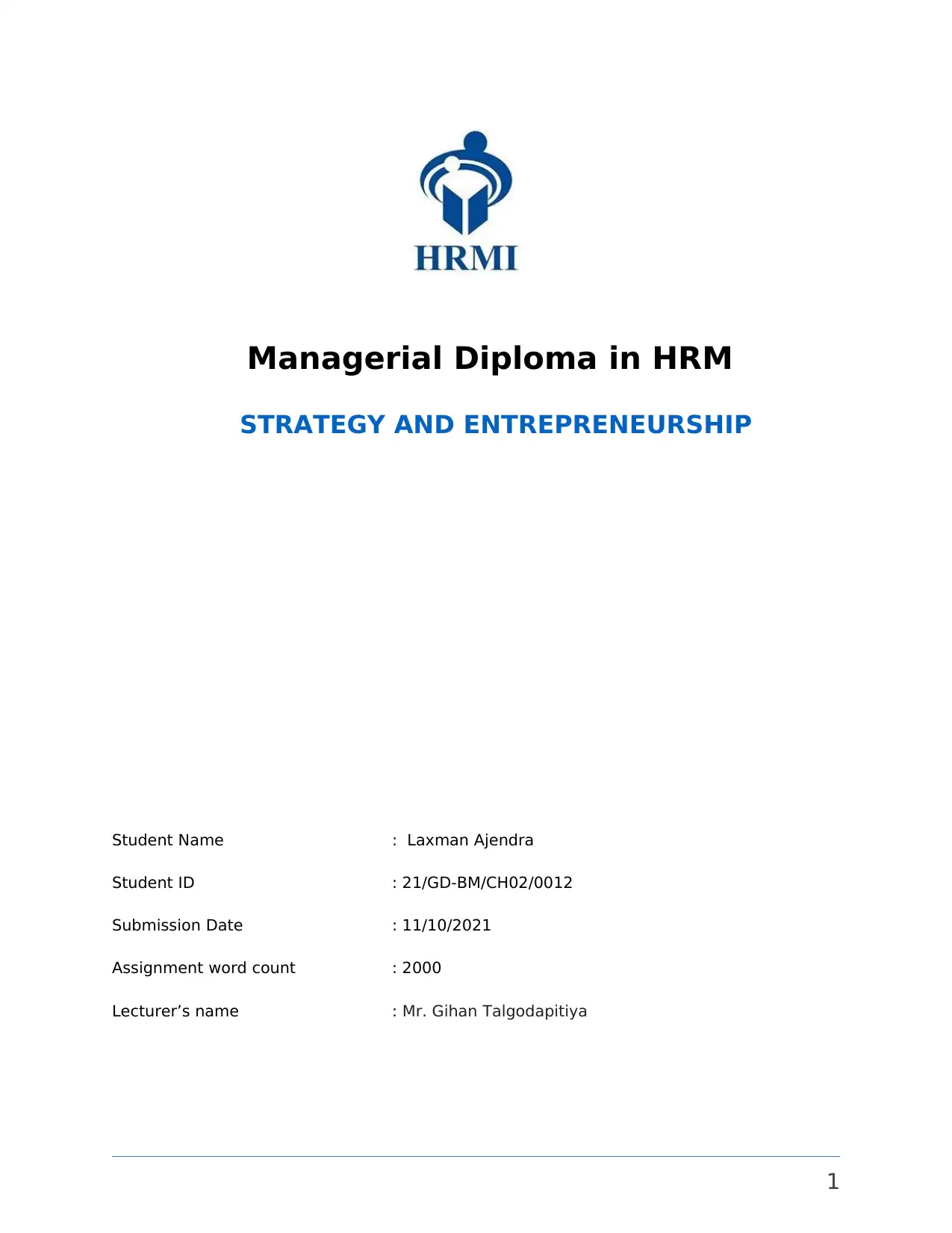
Managerial Diploma in HRM
STRATEGY AND ENTREPRENEURSHIP
Student Name : Laxman Ajendra
Student ID : 21/GD-BM/CH02/0012
Submission Date : 11/10/2021
Assignment word count : 2000
Lecturer’s name : Mr. Gihan Talgodapitiya
1
STRATEGY AND ENTREPRENEURSHIP
Student Name : Laxman Ajendra
Student ID : 21/GD-BM/CH02/0012
Submission Date : 11/10/2021
Assignment word count : 2000
Lecturer’s name : Mr. Gihan Talgodapitiya
1
Paraphrase This Document
Need a fresh take? Get an instant paraphrase of this document with our AI Paraphraser
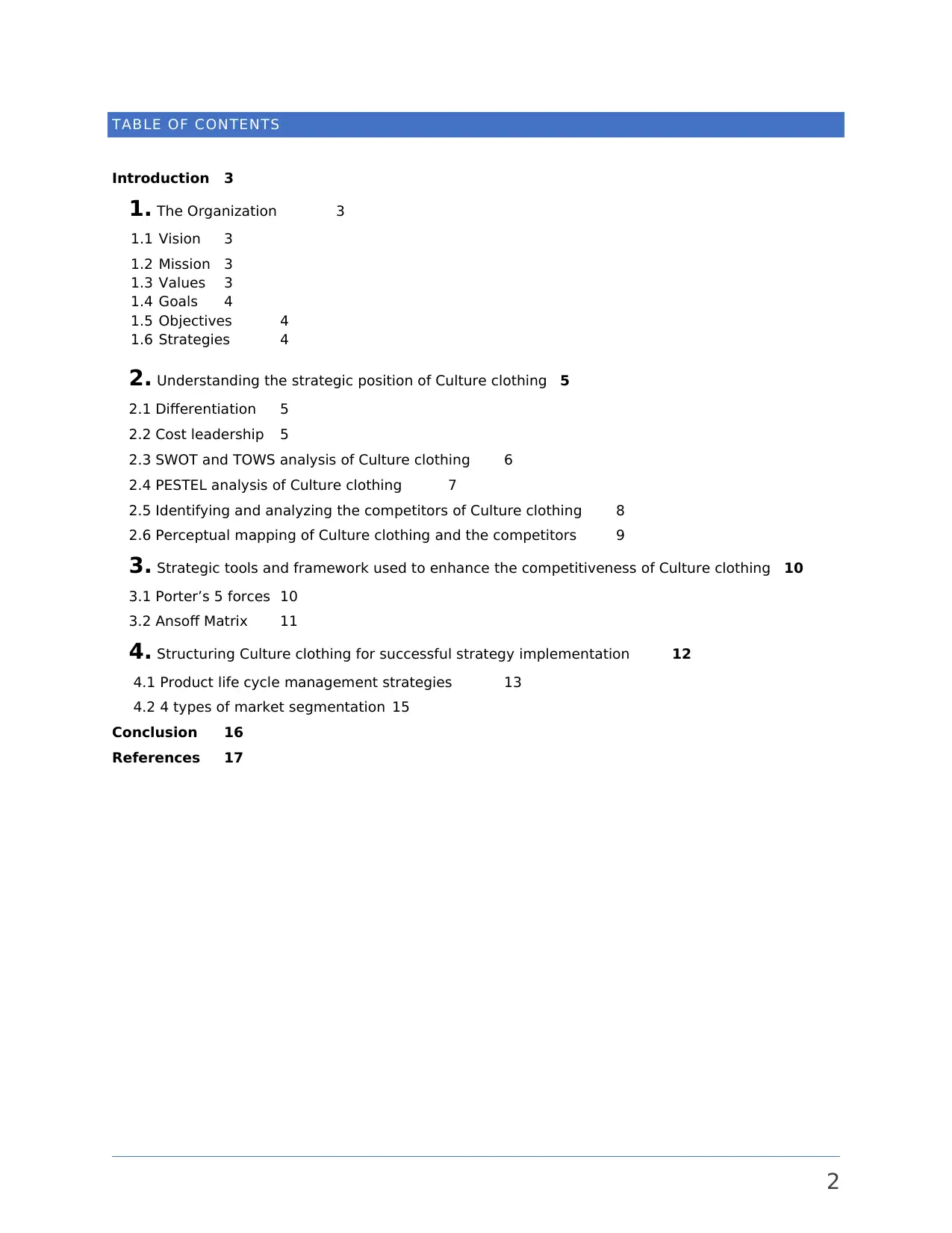
TABLE OF CONTENTS
Introduction 3
1. The Organization 3
1.1 Vision 3
1.2 Mission 3
1.3 Values 3
1.4 Goals 4
1.5 Objectives 4
1.6 Strategies 4
2. Understanding the strategic position of Culture clothing 5
2.1 Differentiation 5
2.2 Cost leadership 5
2.3 SWOT and TOWS analysis of Culture clothing 6
2.4 PESTEL analysis of Culture clothing 7
2.5 Identifying and analyzing the competitors of Culture clothing 8
2.6 Perceptual mapping of Culture clothing and the competitors 9
3. Strategic tools and framework used to enhance the competitiveness of Culture clothing 10
3.1 Porter’s 5 forces 10
3.2 Ansoff Matrix 11
4. Structuring Culture clothing for successful strategy implementation 12
4.1 Product life cycle management strategies 13
4.2 4 types of market segmentation 15
Conclusion 16
References 17
2
Introduction 3
1. The Organization 3
1.1 Vision 3
1.2 Mission 3
1.3 Values 3
1.4 Goals 4
1.5 Objectives 4
1.6 Strategies 4
2. Understanding the strategic position of Culture clothing 5
2.1 Differentiation 5
2.2 Cost leadership 5
2.3 SWOT and TOWS analysis of Culture clothing 6
2.4 PESTEL analysis of Culture clothing 7
2.5 Identifying and analyzing the competitors of Culture clothing 8
2.6 Perceptual mapping of Culture clothing and the competitors 9
3. Strategic tools and framework used to enhance the competitiveness of Culture clothing 10
3.1 Porter’s 5 forces 10
3.2 Ansoff Matrix 11
4. Structuring Culture clothing for successful strategy implementation 12
4.1 Product life cycle management strategies 13
4.2 4 types of market segmentation 15
Conclusion 16
References 17
2
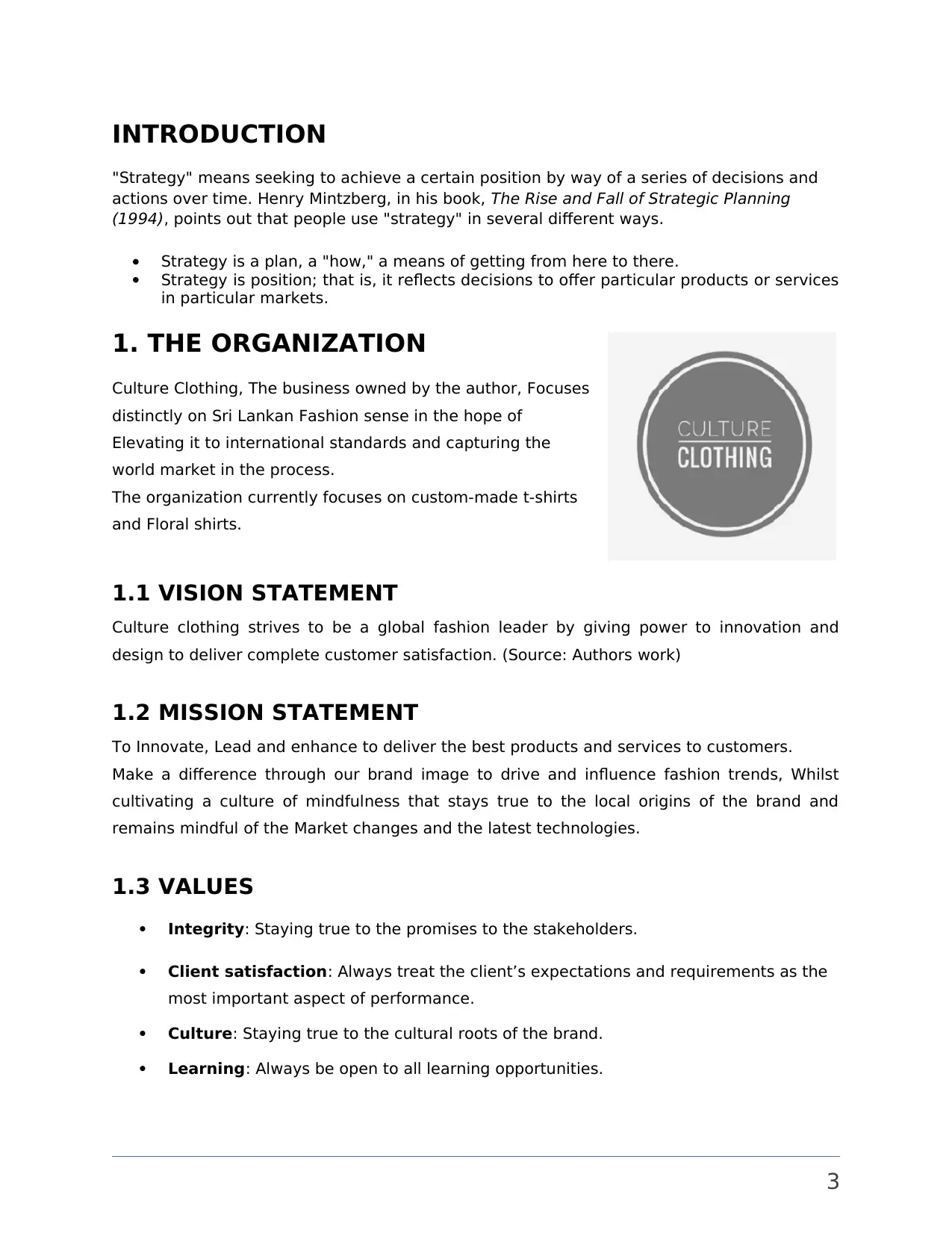
INTRODUCTION
"Strategy" means seeking to achieve a certain position by way of a series of decisions and
actions over time. Henry Mintzberg, in his book, The Rise and Fall of Strategic Planning
(1994), points out that people use "strategy" in several different ways.
Strategy is a plan, a "how," a means of getting from here to there.
Strategy is position; that is, it reflects decisions to offer particular products or services
in particular markets.
1. THE ORGANIZATION
Culture Clothing, The business owned by the author, Focuses
distinctly on Sri Lankan Fashion sense in the hope of
Elevating it to international standards and capturing the
world market in the process.
The organization currently focuses on custom-made t-shirts
and Floral shirts.
1.1 VISION STATEMENT
Culture clothing strives to be a global fashion leader by giving power to innovation and
design to deliver complete customer satisfaction. (Source: Authors work)
1.2 MISSION STATEMENT
To Innovate, Lead and enhance to deliver the best products and services to customers.
Make a difference through our brand image to drive and influence fashion trends, Whilst
cultivating a culture of mindfulness that stays true to the local origins of the brand and
remains mindful of the Market changes and the latest technologies.
1.3 VALUES
Integrity: Staying true to the promises to the stakeholders.
Client satisfaction: Always treat the client’s expectations and requirements as the
most important aspect of performance.
Culture: Staying true to the cultural roots of the brand.
Learning: Always be open to all learning opportunities.
3
"Strategy" means seeking to achieve a certain position by way of a series of decisions and
actions over time. Henry Mintzberg, in his book, The Rise and Fall of Strategic Planning
(1994), points out that people use "strategy" in several different ways.
Strategy is a plan, a "how," a means of getting from here to there.
Strategy is position; that is, it reflects decisions to offer particular products or services
in particular markets.
1. THE ORGANIZATION
Culture Clothing, The business owned by the author, Focuses
distinctly on Sri Lankan Fashion sense in the hope of
Elevating it to international standards and capturing the
world market in the process.
The organization currently focuses on custom-made t-shirts
and Floral shirts.
1.1 VISION STATEMENT
Culture clothing strives to be a global fashion leader by giving power to innovation and
design to deliver complete customer satisfaction. (Source: Authors work)
1.2 MISSION STATEMENT
To Innovate, Lead and enhance to deliver the best products and services to customers.
Make a difference through our brand image to drive and influence fashion trends, Whilst
cultivating a culture of mindfulness that stays true to the local origins of the brand and
remains mindful of the Market changes and the latest technologies.
1.3 VALUES
Integrity: Staying true to the promises to the stakeholders.
Client satisfaction: Always treat the client’s expectations and requirements as the
most important aspect of performance.
Culture: Staying true to the cultural roots of the brand.
Learning: Always be open to all learning opportunities.
3
⊘ This is a preview!⊘
Do you want full access?
Subscribe today to unlock all pages.

Trusted by 1+ million students worldwide
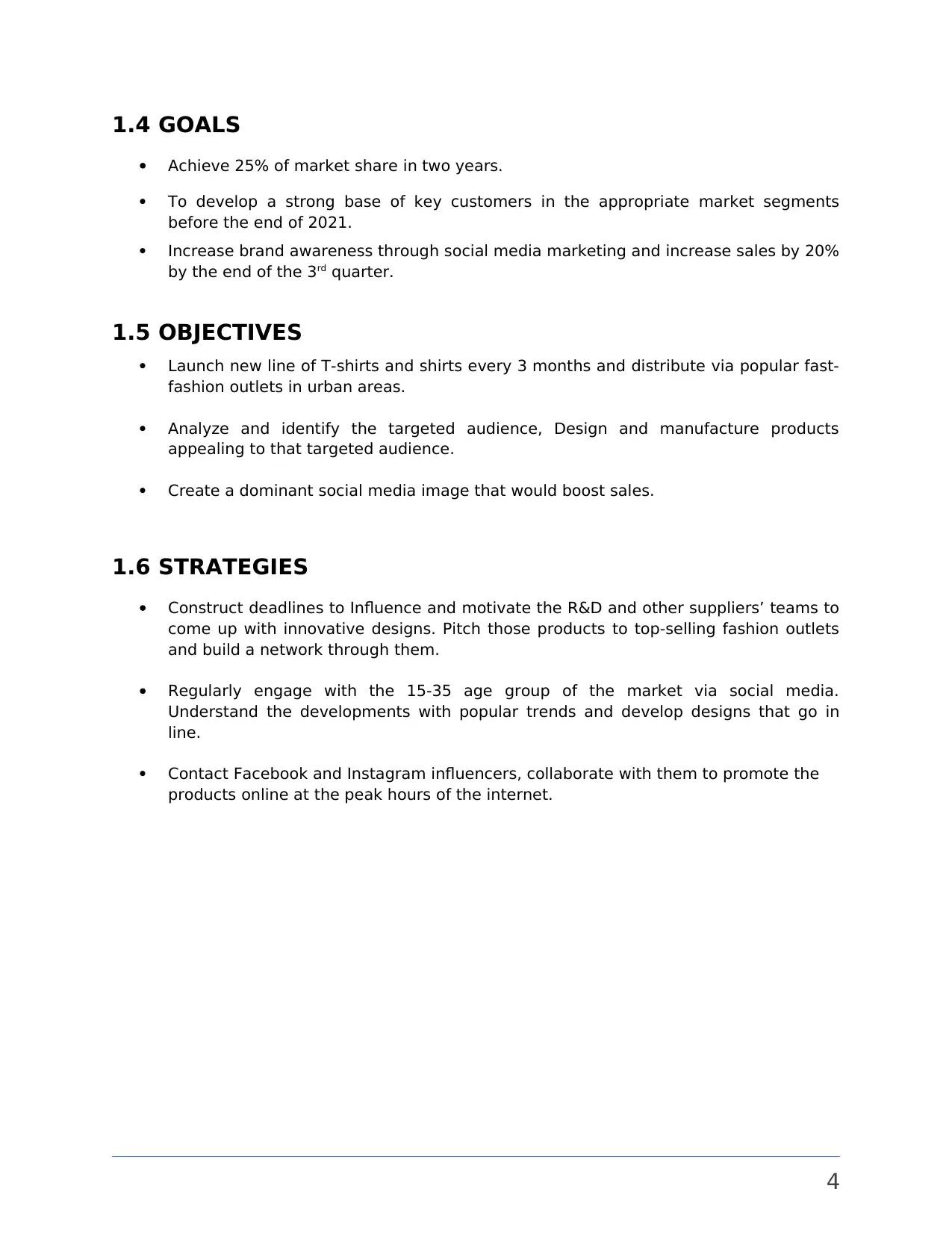
1.4 GOALS
Achieve 25% of market share in two years.
To develop a strong base of key customers in the appropriate market segments
before the end of 2021.
Increase brand awareness through social media marketing and increase sales by 20%
by the end of the 3rd quarter.
1.5 OBJECTIVES
Launch new line of T-shirts and shirts every 3 months and distribute via popular fast-
fashion outlets in urban areas.
Analyze and identify the targeted audience, Design and manufacture products
appealing to that targeted audience.
Create a dominant social media image that would boost sales.
1.6 STRATEGIES
Construct deadlines to Influence and motivate the R&D and other suppliers’ teams to
come up with innovative designs. Pitch those products to top-selling fashion outlets
and build a network through them.
Regularly engage with the 15-35 age group of the market via social media.
Understand the developments with popular trends and develop designs that go in
line.
Contact Facebook and Instagram influencers, collaborate with them to promote the
products online at the peak hours of the internet.
4
Achieve 25% of market share in two years.
To develop a strong base of key customers in the appropriate market segments
before the end of 2021.
Increase brand awareness through social media marketing and increase sales by 20%
by the end of the 3rd quarter.
1.5 OBJECTIVES
Launch new line of T-shirts and shirts every 3 months and distribute via popular fast-
fashion outlets in urban areas.
Analyze and identify the targeted audience, Design and manufacture products
appealing to that targeted audience.
Create a dominant social media image that would boost sales.
1.6 STRATEGIES
Construct deadlines to Influence and motivate the R&D and other suppliers’ teams to
come up with innovative designs. Pitch those products to top-selling fashion outlets
and build a network through them.
Regularly engage with the 15-35 age group of the market via social media.
Understand the developments with popular trends and develop designs that go in
line.
Contact Facebook and Instagram influencers, collaborate with them to promote the
products online at the peak hours of the internet.
4
Paraphrase This Document
Need a fresh take? Get an instant paraphrase of this document with our AI Paraphraser
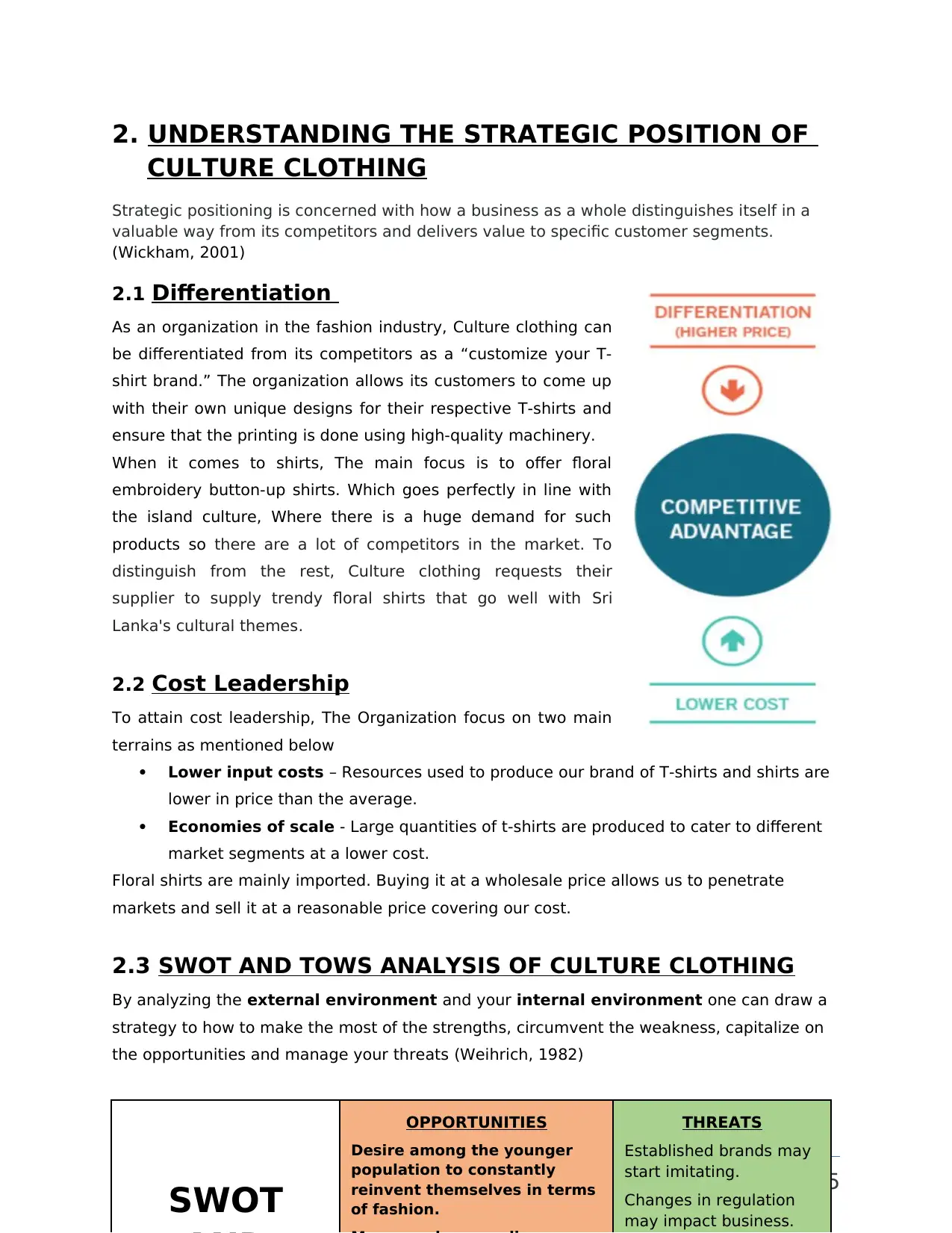
2. UNDERSTANDING THE STRATEGIC POSITION OF
CULTURE CLOTHING
Strategic positioning is concerned with how a business as a whole distinguishes itself in a
valuable way from its competitors and delivers value to specific customer segments.
(Wickham, 2001)
2.1 Differentiation
As an organization in the fashion industry, Culture clothing can
be differentiated from its competitors as a “customize your T-
shirt brand.” The organization allows its customers to come up
with their own unique designs for their respective T-shirts and
ensure that the printing is done using high-quality machinery.
When it comes to shirts, The main focus is to offer floral
embroidery button-up shirts. Which goes perfectly in line with
the island culture, Where there is a huge demand for such
products so there are a lot of competitors in the market. To
distinguish from the rest, Culture clothing requests their
supplier to supply trendy floral shirts that go well with Sri
Lanka's cultural themes.
2.2 Cost Leadership
To attain cost leadership, The Organization focus on two main
terrains as mentioned below
Lower input costs – Resources used to produce our brand of T-shirts and shirts are
lower in price than the average.
Economies of scale - Large quantities of t-shirts are produced to cater to different
market segments at a lower cost.
Floral shirts are mainly imported. Buying it at a wholesale price allows us to penetrate
markets and sell it at a reasonable price covering our cost.
2.3 SWOT AND TOWS ANALYSIS OF CULTURE CLOTHING
By analyzing the external environment and your internal environment one can draw a
strategy to how to make the most of the strengths, circumvent the weakness, capitalize on
the opportunities and manage your threats (Weihrich, 1982)
5
SWOT
OPPORTUNITIES
Desire among the younger
population to constantly
reinvent themselves in terms
of fashion.
THREATS
Established brands may
start imitating.
Changes in regulation
may impact business.
CULTURE CLOTHING
Strategic positioning is concerned with how a business as a whole distinguishes itself in a
valuable way from its competitors and delivers value to specific customer segments.
(Wickham, 2001)
2.1 Differentiation
As an organization in the fashion industry, Culture clothing can
be differentiated from its competitors as a “customize your T-
shirt brand.” The organization allows its customers to come up
with their own unique designs for their respective T-shirts and
ensure that the printing is done using high-quality machinery.
When it comes to shirts, The main focus is to offer floral
embroidery button-up shirts. Which goes perfectly in line with
the island culture, Where there is a huge demand for such
products so there are a lot of competitors in the market. To
distinguish from the rest, Culture clothing requests their
supplier to supply trendy floral shirts that go well with Sri
Lanka's cultural themes.
2.2 Cost Leadership
To attain cost leadership, The Organization focus on two main
terrains as mentioned below
Lower input costs – Resources used to produce our brand of T-shirts and shirts are
lower in price than the average.
Economies of scale - Large quantities of t-shirts are produced to cater to different
market segments at a lower cost.
Floral shirts are mainly imported. Buying it at a wholesale price allows us to penetrate
markets and sell it at a reasonable price covering our cost.
2.3 SWOT AND TOWS ANALYSIS OF CULTURE CLOTHING
By analyzing the external environment and your internal environment one can draw a
strategy to how to make the most of the strengths, circumvent the weakness, capitalize on
the opportunities and manage your threats (Weihrich, 1982)
5
SWOT
OPPORTUNITIES
Desire among the younger
population to constantly
reinvent themselves in terms
of fashion.
THREATS
Established brands may
start imitating.
Changes in regulation
may impact business.
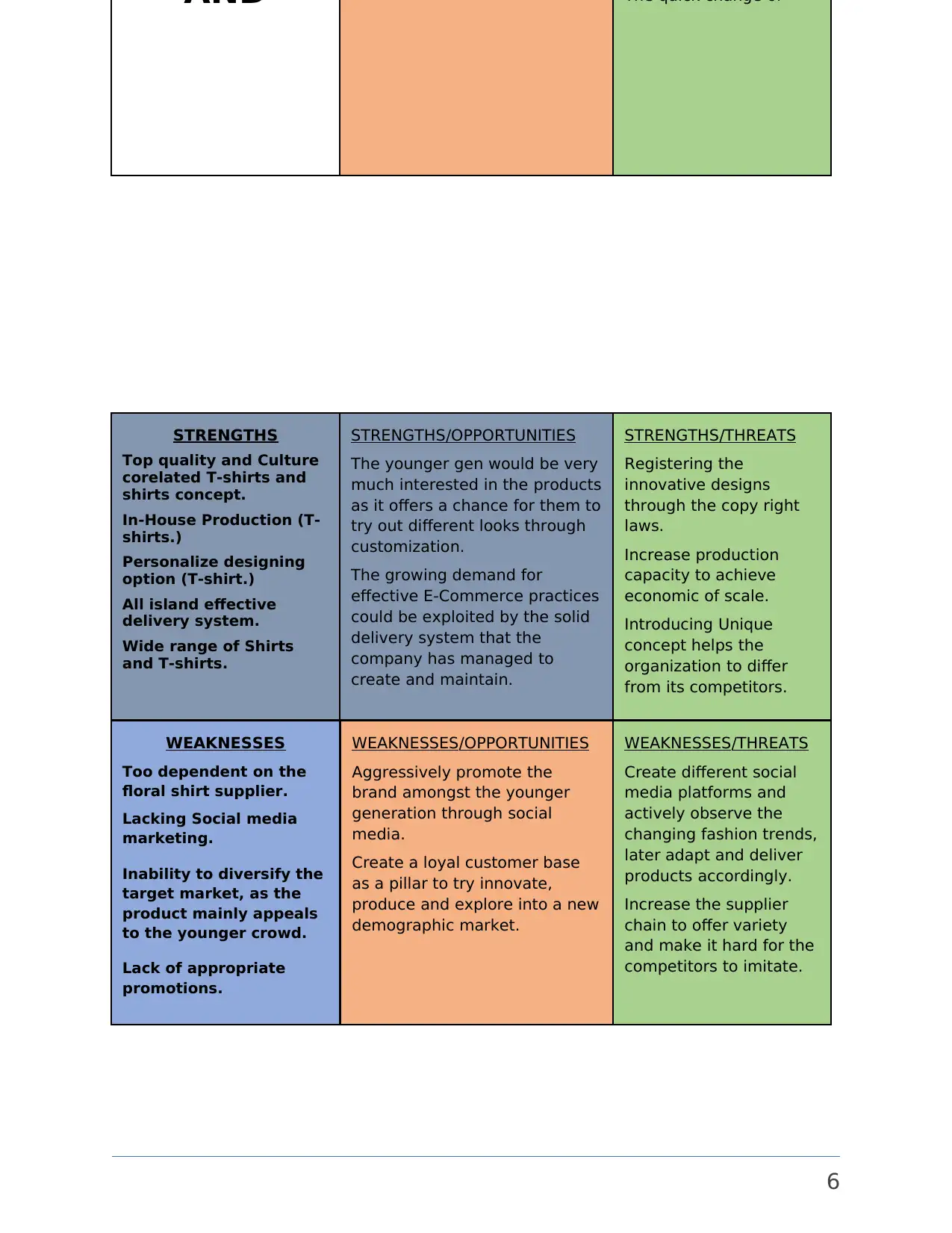
6
AND The quick change of
STRENGTHS
Top quality and Culture
corelated T-shirts and
shirts concept.
In-House Production (T-
shirts.)
Personalize designing
option (T-shirt.)
All island effective
delivery system.
Wide range of Shirts
and T-shirts.
STRENGTHS/OPPORTUNITIES
The younger gen would be very
much interested in the products
as it offers a chance for them to
try out different looks through
customization.
The growing demand for
effective E-Commerce practices
could be exploited by the solid
delivery system that the
company has managed to
create and maintain.
STRENGTHS/THREATS
Registering the
innovative designs
through the copy right
laws.
Increase production
capacity to achieve
economic of scale.
Introducing Unique
concept helps the
organization to differ
from its competitors.
WEAKNESSES
Too dependent on the
floral shirt supplier.
Lacking Social media
marketing.
Inability to diversify the
target market, as the
product mainly appeals
to the younger crowd.
Lack of appropriate
promotions.
WEAKNESSES/OPPORTUNITIES
Aggressively promote the
brand amongst the younger
generation through social
media.
Create a loyal customer base
as a pillar to try innovate,
produce and explore into a new
demographic market.
WEAKNESSES/THREATS
Create different social
media platforms and
actively observe the
changing fashion trends,
later adapt and deliver
products accordingly.
Increase the supplier
chain to offer variety
and make it hard for the
competitors to imitate.
AND The quick change of
STRENGTHS
Top quality and Culture
corelated T-shirts and
shirts concept.
In-House Production (T-
shirts.)
Personalize designing
option (T-shirt.)
All island effective
delivery system.
Wide range of Shirts
and T-shirts.
STRENGTHS/OPPORTUNITIES
The younger gen would be very
much interested in the products
as it offers a chance for them to
try out different looks through
customization.
The growing demand for
effective E-Commerce practices
could be exploited by the solid
delivery system that the
company has managed to
create and maintain.
STRENGTHS/THREATS
Registering the
innovative designs
through the copy right
laws.
Increase production
capacity to achieve
economic of scale.
Introducing Unique
concept helps the
organization to differ
from its competitors.
WEAKNESSES
Too dependent on the
floral shirt supplier.
Lacking Social media
marketing.
Inability to diversify the
target market, as the
product mainly appeals
to the younger crowd.
Lack of appropriate
promotions.
WEAKNESSES/OPPORTUNITIES
Aggressively promote the
brand amongst the younger
generation through social
media.
Create a loyal customer base
as a pillar to try innovate,
produce and explore into a new
demographic market.
WEAKNESSES/THREATS
Create different social
media platforms and
actively observe the
changing fashion trends,
later adapt and deliver
products accordingly.
Increase the supplier
chain to offer variety
and make it hard for the
competitors to imitate.
⊘ This is a preview!⊘
Do you want full access?
Subscribe today to unlock all pages.

Trusted by 1+ million students worldwide
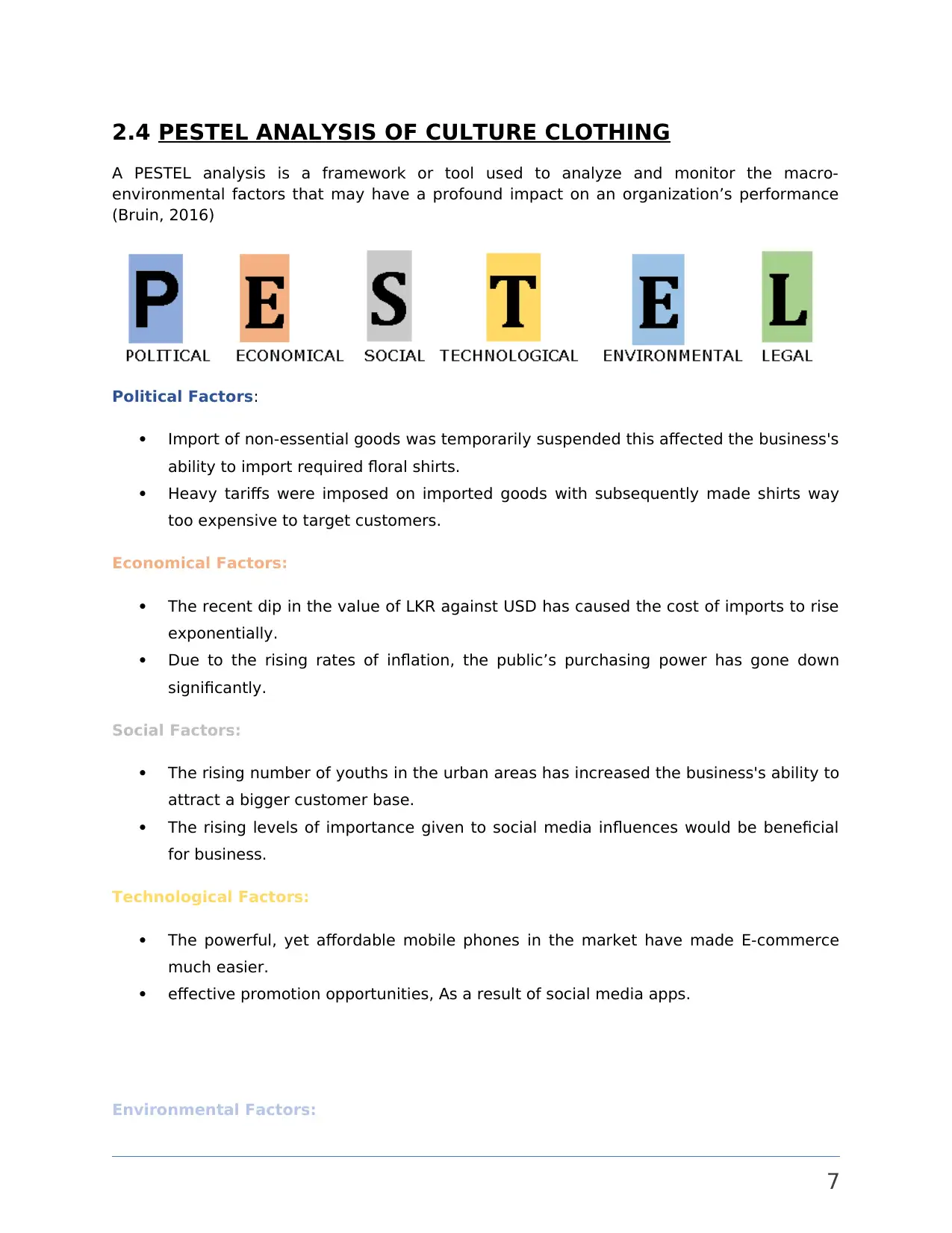
2.4 PESTEL ANALYSIS OF CULTURE CLOTHING
A PESTEL analysis is a framework or tool used to analyze and monitor the macro-
environmental factors that may have a profound impact on an organization’s performance
(Bruin, 2016)
Political Factors:
Import of non-essential goods was temporarily suspended this affected the business's
ability to import required floral shirts.
Heavy tariffs were imposed on imported goods with subsequently made shirts way
too expensive to target customers.
Economical Factors:
The recent dip in the value of LKR against USD has caused the cost of imports to rise
exponentially.
Due to the rising rates of inflation, the public’s purchasing power has gone down
significantly.
Social Factors:
The rising number of youths in the urban areas has increased the business's ability to
attract a bigger customer base.
The rising levels of importance given to social media influences would be beneficial
for business.
Technological Factors:
The powerful, yet affordable mobile phones in the market have made E-commerce
much easier.
effective promotion opportunities, As a result of social media apps.
Environmental Factors:
7
A PESTEL analysis is a framework or tool used to analyze and monitor the macro-
environmental factors that may have a profound impact on an organization’s performance
(Bruin, 2016)
Political Factors:
Import of non-essential goods was temporarily suspended this affected the business's
ability to import required floral shirts.
Heavy tariffs were imposed on imported goods with subsequently made shirts way
too expensive to target customers.
Economical Factors:
The recent dip in the value of LKR against USD has caused the cost of imports to rise
exponentially.
Due to the rising rates of inflation, the public’s purchasing power has gone down
significantly.
Social Factors:
The rising number of youths in the urban areas has increased the business's ability to
attract a bigger customer base.
The rising levels of importance given to social media influences would be beneficial
for business.
Technological Factors:
The powerful, yet affordable mobile phones in the market have made E-commerce
much easier.
effective promotion opportunities, As a result of social media apps.
Environmental Factors:
7
Paraphrase This Document
Need a fresh take? Get an instant paraphrase of this document with our AI Paraphraser
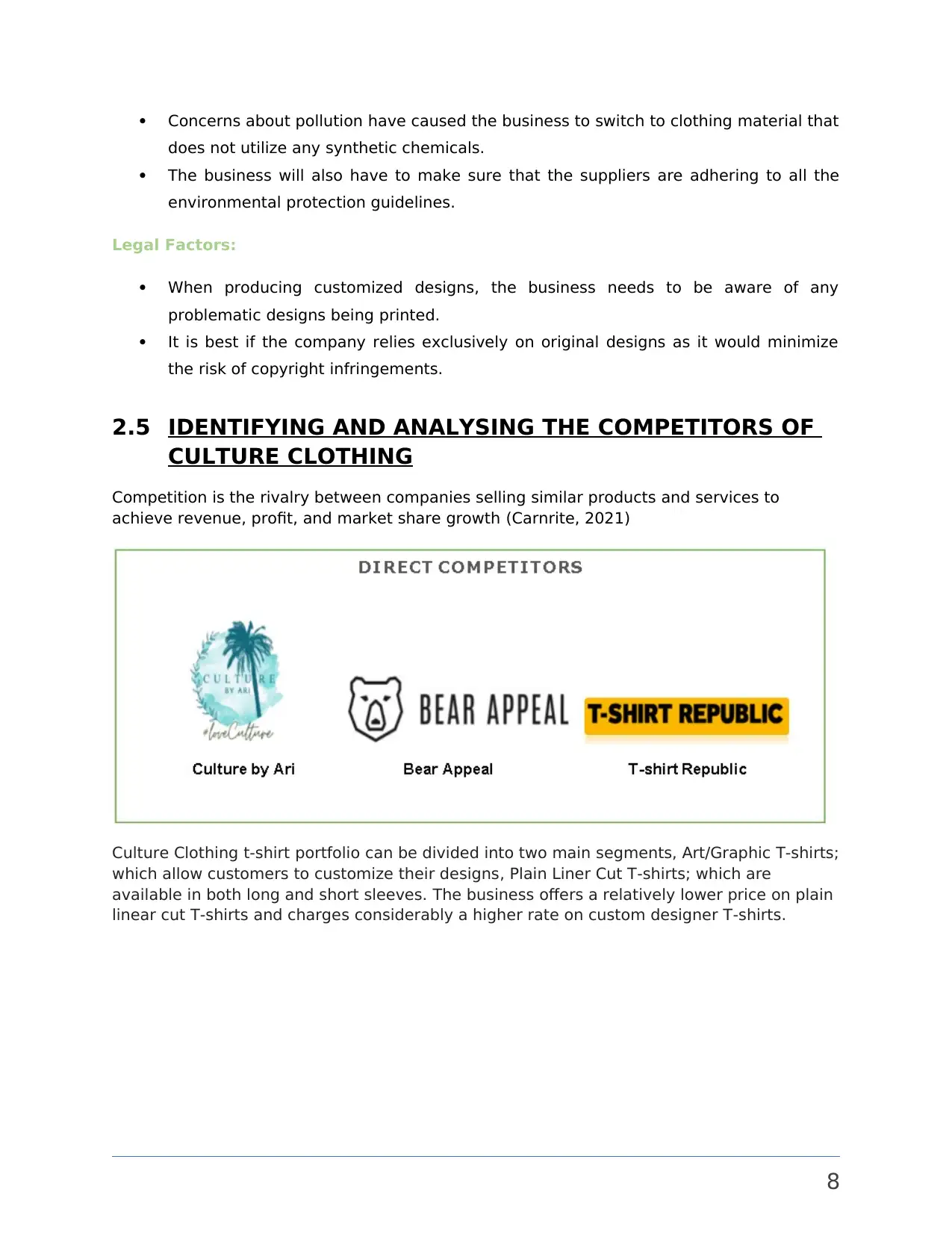
Concerns about pollution have caused the business to switch to clothing material that
does not utilize any synthetic chemicals.
The business will also have to make sure that the suppliers are adhering to all the
environmental protection guidelines.
Legal Factors:
When producing customized designs, the business needs to be aware of any
problematic designs being printed.
It is best if the company relies exclusively on original designs as it would minimize
the risk of copyright infringements.
2.5 IDENTIFYING AND ANALYSING THE COMPETITORS OF
CULTURE CLOTHING
Competition is the rivalry between companies selling similar products and services to
achieve revenue, profit, and market share growth (Carnrite, 2021)
Culture Clothing t-shirt portfolio can be divided into two main segments, Art/Graphic T-shirts;
which allow customers to customize their designs, Plain Liner Cut T-shirts; which are
available in both long and short sleeves. The business offers a relatively lower price on plain
linear cut T-shirts and charges considerably a higher rate on custom designer T-shirts.
8
does not utilize any synthetic chemicals.
The business will also have to make sure that the suppliers are adhering to all the
environmental protection guidelines.
Legal Factors:
When producing customized designs, the business needs to be aware of any
problematic designs being printed.
It is best if the company relies exclusively on original designs as it would minimize
the risk of copyright infringements.
2.5 IDENTIFYING AND ANALYSING THE COMPETITORS OF
CULTURE CLOTHING
Competition is the rivalry between companies selling similar products and services to
achieve revenue, profit, and market share growth (Carnrite, 2021)
Culture Clothing t-shirt portfolio can be divided into two main segments, Art/Graphic T-shirts;
which allow customers to customize their designs, Plain Liner Cut T-shirts; which are
available in both long and short sleeves. The business offers a relatively lower price on plain
linear cut T-shirts and charges considerably a higher rate on custom designer T-shirts.
8
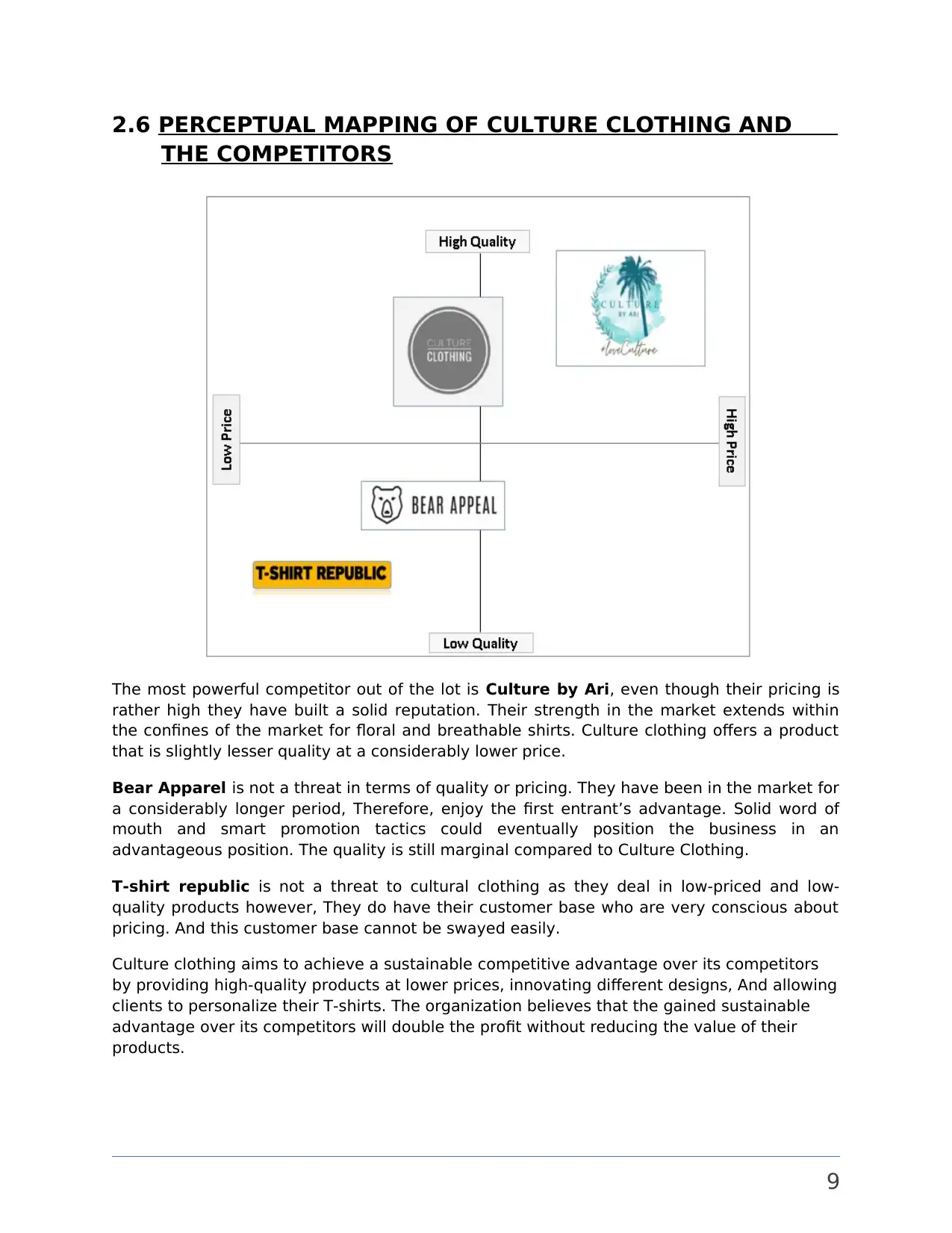
2.6 PERCEPTUAL MAPPING OF CULTURE CLOTHING AND
THE COMPETITORS
The most powerful competitor out of the lot is Culture by Ari, even though their pricing is
rather high they have built a solid reputation. Their strength in the market extends within
the confines of the market for floral and breathable shirts. Culture clothing offers a product
that is slightly lesser quality at a considerably lower price.
Bear Apparel is not a threat in terms of quality or pricing. They have been in the market for
a considerably longer period, Therefore, enjoy the first entrant’s advantage. Solid word of
mouth and smart promotion tactics could eventually position the business in an
advantageous position. The quality is still marginal compared to Culture Clothing.
T-shirt republic is not a threat to cultural clothing as they deal in low-priced and low-
quality products however, They do have their customer base who are very conscious about
pricing. And this customer base cannot be swayed easily.
Culture clothing aims to achieve a sustainable competitive advantage over its competitors
by providing high-quality products at lower prices, innovating different designs, And allowing
clients to personalize their T-shirts. The organization believes that the gained sustainable
advantage over its competitors will double the profit without reducing the value of their
products.
9
THE COMPETITORS
The most powerful competitor out of the lot is Culture by Ari, even though their pricing is
rather high they have built a solid reputation. Their strength in the market extends within
the confines of the market for floral and breathable shirts. Culture clothing offers a product
that is slightly lesser quality at a considerably lower price.
Bear Apparel is not a threat in terms of quality or pricing. They have been in the market for
a considerably longer period, Therefore, enjoy the first entrant’s advantage. Solid word of
mouth and smart promotion tactics could eventually position the business in an
advantageous position. The quality is still marginal compared to Culture Clothing.
T-shirt republic is not a threat to cultural clothing as they deal in low-priced and low-
quality products however, They do have their customer base who are very conscious about
pricing. And this customer base cannot be swayed easily.
Culture clothing aims to achieve a sustainable competitive advantage over its competitors
by providing high-quality products at lower prices, innovating different designs, And allowing
clients to personalize their T-shirts. The organization believes that the gained sustainable
advantage over its competitors will double the profit without reducing the value of their
products.
9
⊘ This is a preview!⊘
Do you want full access?
Subscribe today to unlock all pages.

Trusted by 1+ million students worldwide
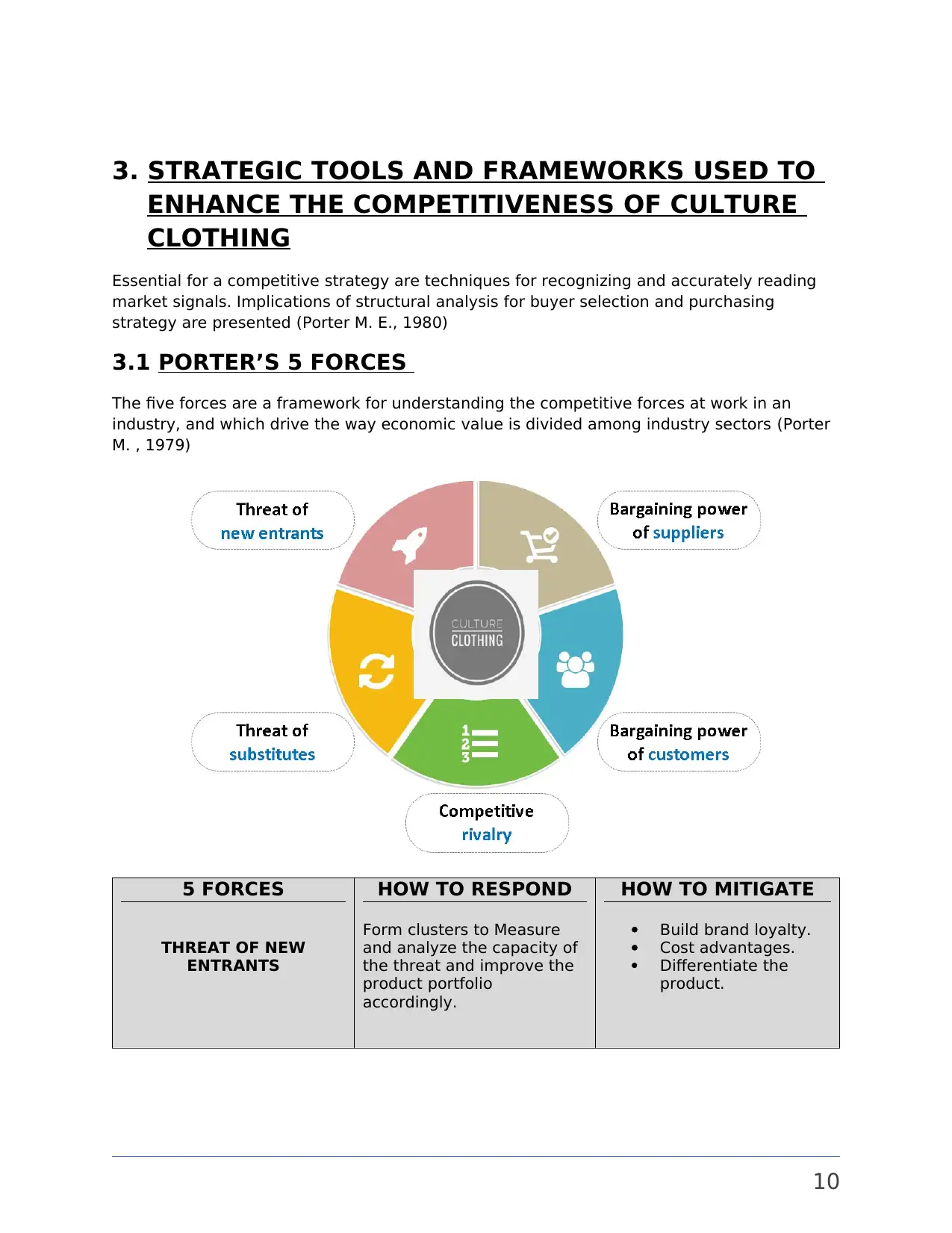
3. STRATEGIC TOOLS AND FRAMEWORKS USED TO
ENHANCE THE COMPETITIVENESS OF CULTURE
CLOTHING
Essential for a competitive strategy are techniques for recognizing and accurately reading
market signals. Implications of structural analysis for buyer selection and purchasing
strategy are presented (Porter M. E., 1980)
3.1 PORTER’S 5 FORCES
The five forces are a framework for understanding the competitive forces at work in an
industry, and which drive the way economic value is divided among industry sectors (Porter
M. , 1979)
5 FORCES
THREAT OF NEW
ENTRANTS
HOW TO RESPOND
Form clusters to Measure
and analyze the capacity of
the threat and improve the
product portfolio
accordingly.
HOW TO MITIGATE
Build brand loyalty.
Cost advantages.
Differentiate the
product.
10
ENHANCE THE COMPETITIVENESS OF CULTURE
CLOTHING
Essential for a competitive strategy are techniques for recognizing and accurately reading
market signals. Implications of structural analysis for buyer selection and purchasing
strategy are presented (Porter M. E., 1980)
3.1 PORTER’S 5 FORCES
The five forces are a framework for understanding the competitive forces at work in an
industry, and which drive the way economic value is divided among industry sectors (Porter
M. , 1979)
5 FORCES
THREAT OF NEW
ENTRANTS
HOW TO RESPOND
Form clusters to Measure
and analyze the capacity of
the threat and improve the
product portfolio
accordingly.
HOW TO MITIGATE
Build brand loyalty.
Cost advantages.
Differentiate the
product.
10
Paraphrase This Document
Need a fresh take? Get an instant paraphrase of this document with our AI Paraphraser
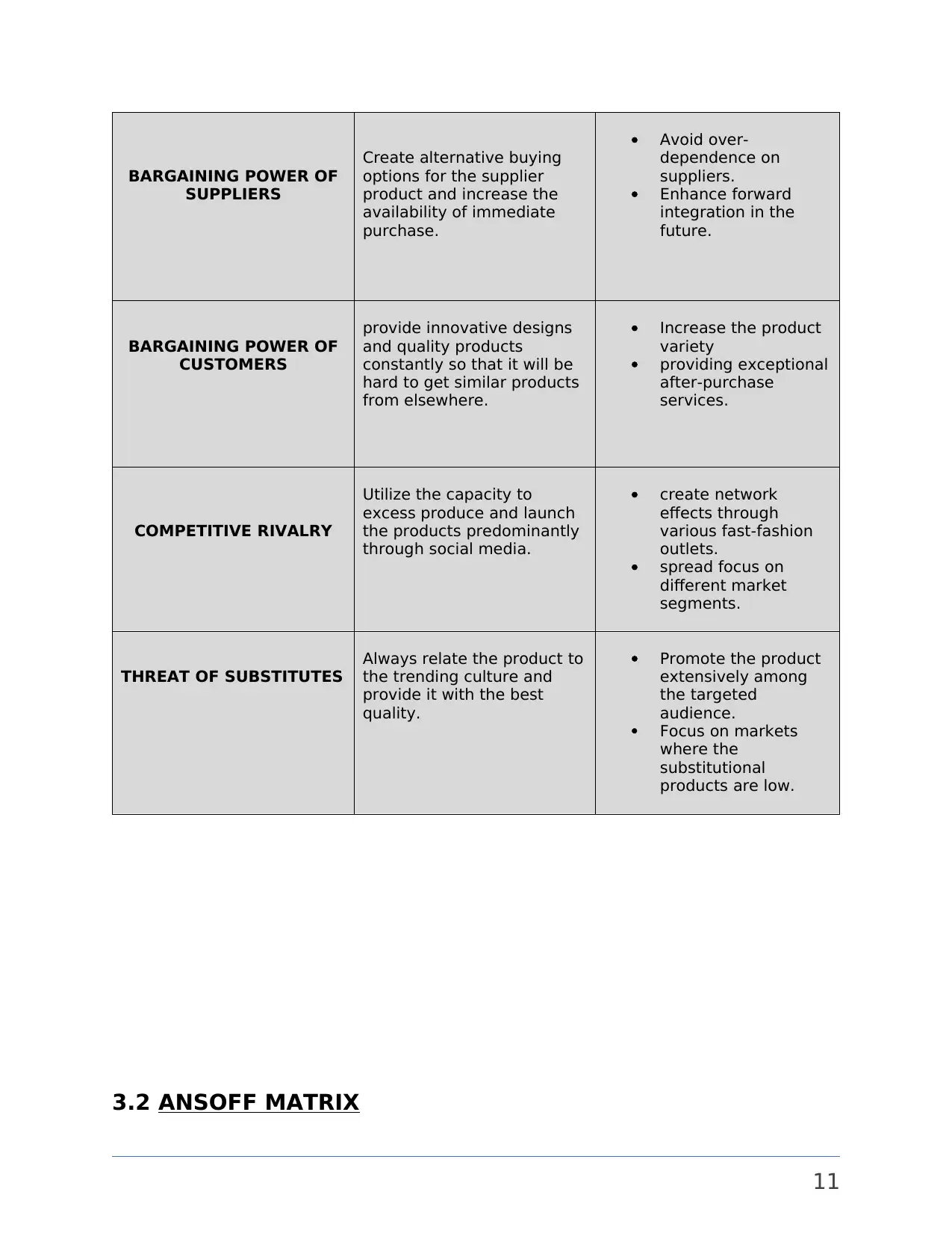
BARGAINING POWER OF
SUPPLIERS
Create alternative buying
options for the supplier
product and increase the
availability of immediate
purchase.
Avoid over-
dependence on
suppliers.
Enhance forward
integration in the
future.
BARGAINING POWER OF
CUSTOMERS
provide innovative designs
and quality products
constantly so that it will be
hard to get similar products
from elsewhere.
Increase the product
variety
providing exceptional
after-purchase
services.
COMPETITIVE RIVALRY
Utilize the capacity to
excess produce and launch
the products predominantly
through social media.
create network
effects through
various fast-fashion
outlets.
spread focus on
different market
segments.
THREAT OF SUBSTITUTES
Always relate the product to
the trending culture and
provide it with the best
quality.
Promote the product
extensively among
the targeted
audience.
Focus on markets
where the
substitutional
products are low.
3.2 ANSOFF MATRIX
11
SUPPLIERS
Create alternative buying
options for the supplier
product and increase the
availability of immediate
purchase.
Avoid over-
dependence on
suppliers.
Enhance forward
integration in the
future.
BARGAINING POWER OF
CUSTOMERS
provide innovative designs
and quality products
constantly so that it will be
hard to get similar products
from elsewhere.
Increase the product
variety
providing exceptional
after-purchase
services.
COMPETITIVE RIVALRY
Utilize the capacity to
excess produce and launch
the products predominantly
through social media.
create network
effects through
various fast-fashion
outlets.
spread focus on
different market
segments.
THREAT OF SUBSTITUTES
Always relate the product to
the trending culture and
provide it with the best
quality.
Promote the product
extensively among
the targeted
audience.
Focus on markets
where the
substitutional
products are low.
3.2 ANSOFF MATRIX
11
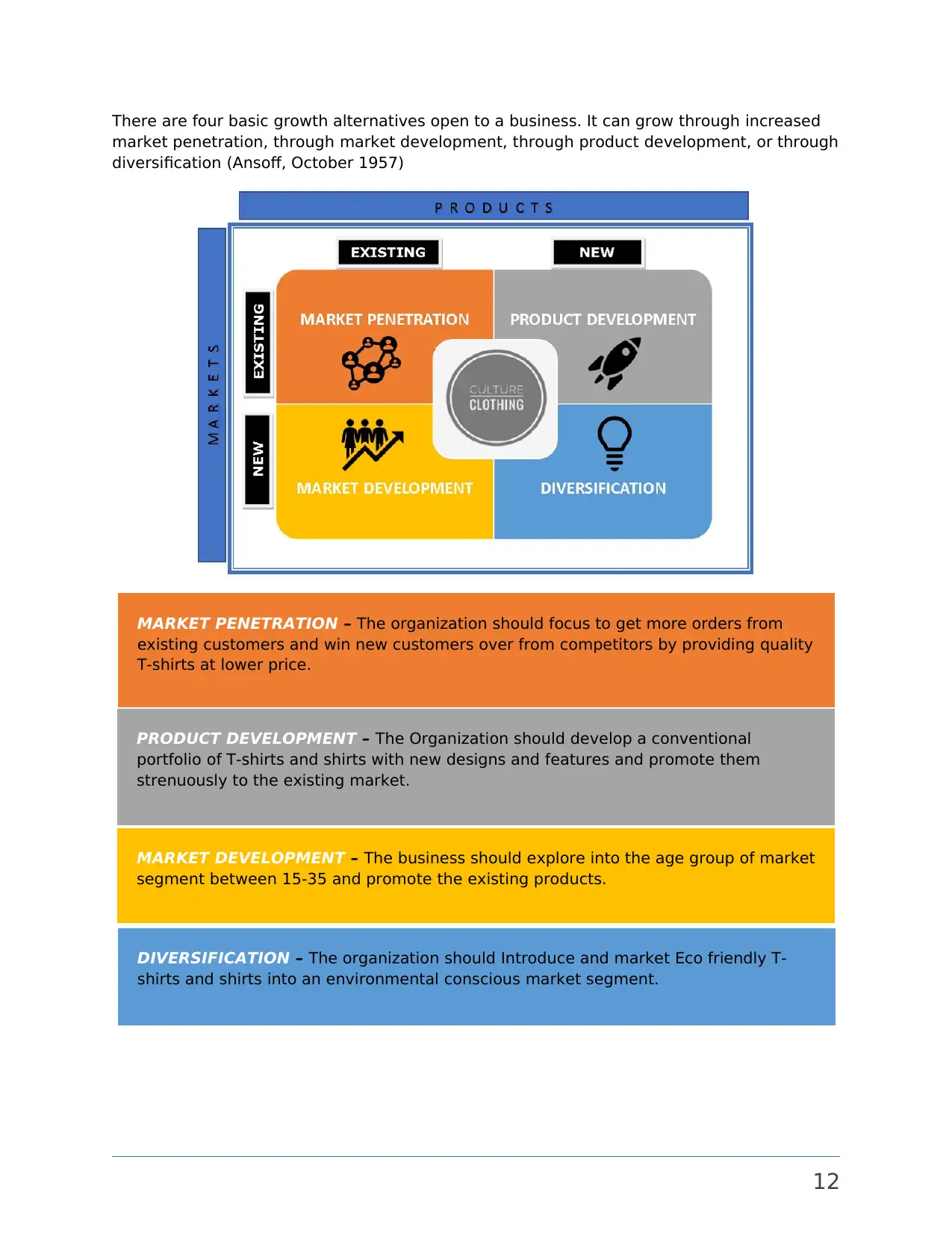
There are four basic growth alternatives open to a business. It can grow through increased
market penetration, through market development, through product development, or through
diversification (Ansoff, October 1957)
12
MARKET PENETRATION – The organization should focus to get more orders from
existing customers and win new customers over from competitors by providing quality
T-shirts at lower price.
PRODUCT DEVELOPMENT – The Organization should develop a conventional
portfolio of T-shirts and shirts with new designs and features and promote them
strenuously to the existing market.
MARKET DEVELOPMENT – The business should explore into the age group of market
segment between 15-35 and promote the existing products.
DIVERSIFICATION – The organization should Introduce and market Eco friendly T-
shirts and shirts into an environmental conscious market segment.
market penetration, through market development, through product development, or through
diversification (Ansoff, October 1957)
12
MARKET PENETRATION – The organization should focus to get more orders from
existing customers and win new customers over from competitors by providing quality
T-shirts at lower price.
PRODUCT DEVELOPMENT – The Organization should develop a conventional
portfolio of T-shirts and shirts with new designs and features and promote them
strenuously to the existing market.
MARKET DEVELOPMENT – The business should explore into the age group of market
segment between 15-35 and promote the existing products.
DIVERSIFICATION – The organization should Introduce and market Eco friendly T-
shirts and shirts into an environmental conscious market segment.
⊘ This is a preview!⊘
Do you want full access?
Subscribe today to unlock all pages.

Trusted by 1+ million students worldwide
1 out of 17
Related Documents
Your All-in-One AI-Powered Toolkit for Academic Success.
+13062052269
info@desklib.com
Available 24*7 on WhatsApp / Email
![[object Object]](/_next/static/media/star-bottom.7253800d.svg)
Unlock your academic potential
Copyright © 2020–2025 A2Z Services. All Rights Reserved. Developed and managed by ZUCOL.




